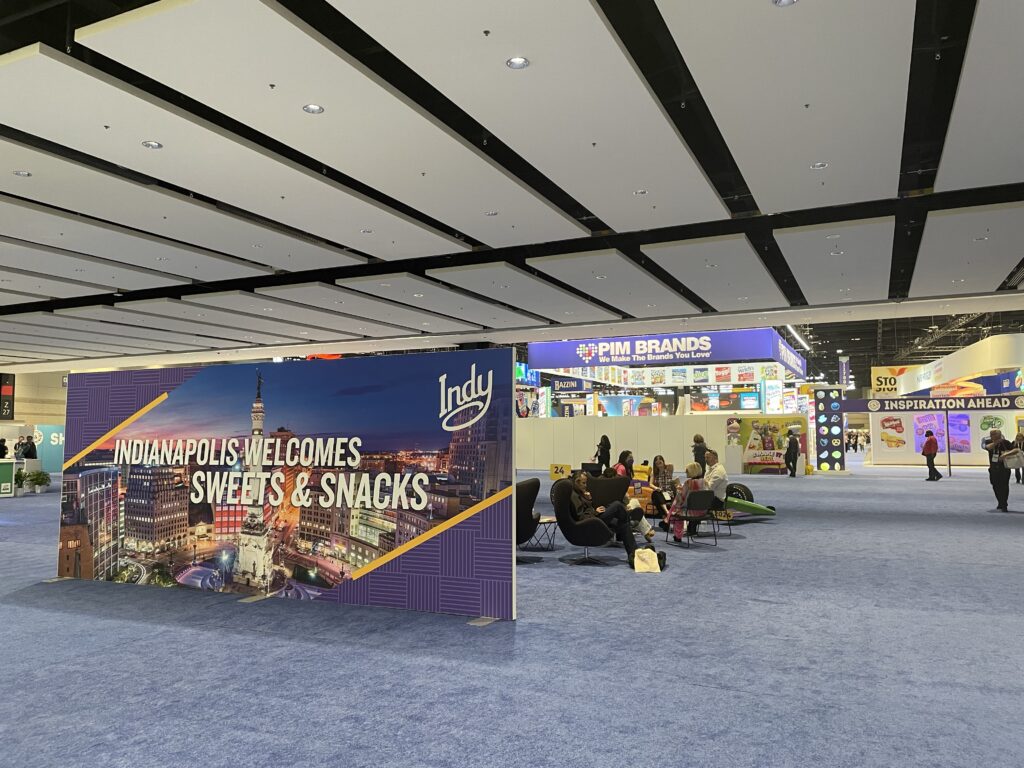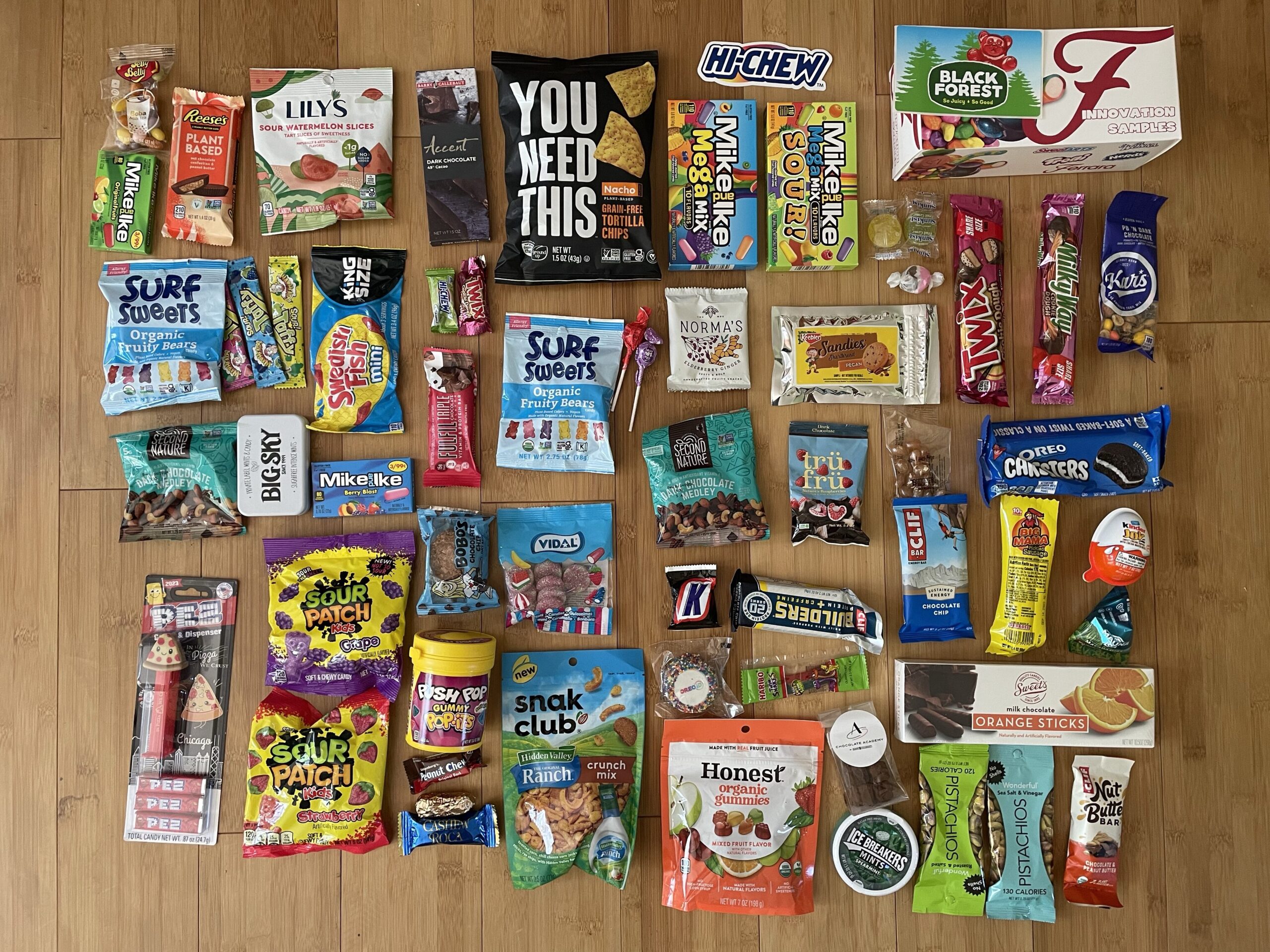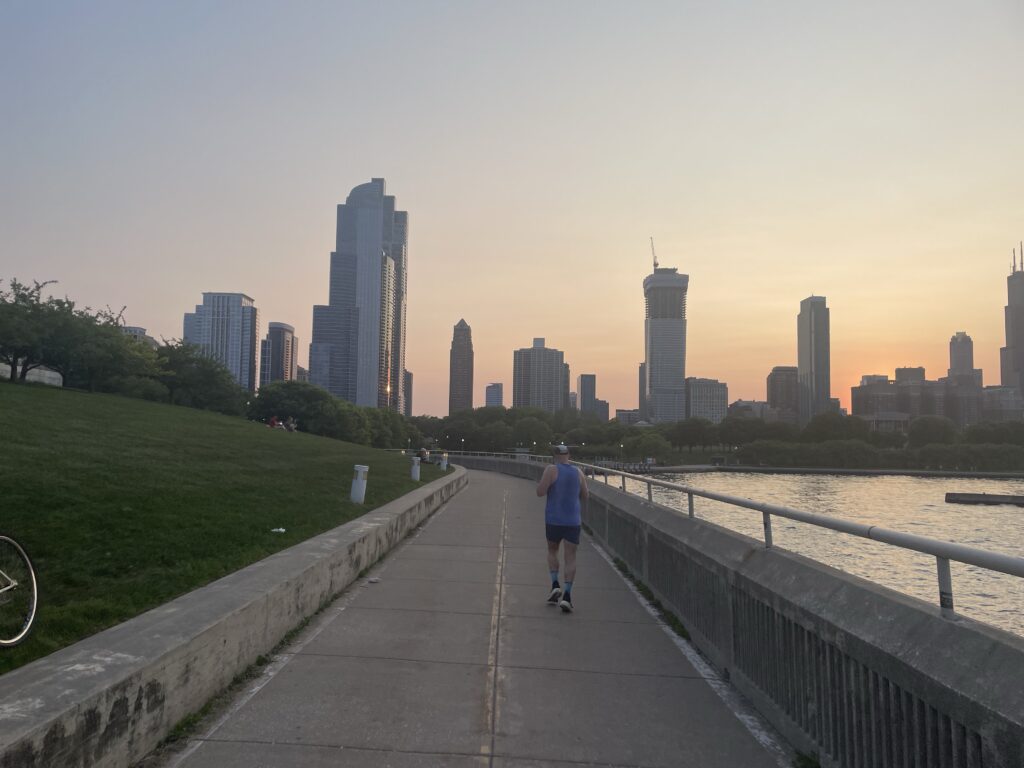Every year, the National Confectioners Association, an industry group that represents candy and snacks producers, hosts an enormous conference called the Sweets & Snacks Expo, in Chicago, IL (although they’re moving to Las Vegas and Indianapolis in the next 10 years). This conference is the largest of its kind in the world, hosting over 16,000 attendees annually, and important, because it’s where candy buyers (think the Walmarts and Targets of the world) sign deals with candy manufacturers large and small. That’s why I thought it was super cool to have the opportunity to attend the conference as an undergraduate student.
How did this happen? A few months ago, I applied for The Confectionery Foundation’s NextGen program after a professor at the University of Southern California mentioned it. The conference is traditionally invite-only (i.e., not open to the public), so this is one of the few opportunities for people outside confectionery to get an inside look on the industry. The NextGen program is exclusively for students – both traditional postsecondary students, and culinary students. I don’t know how selective the program is, but I did have to undergo a simple resume and phone screen as part of the application process. You can learn more about the NextGen program here.
The Conference
The NextGen program offers students two tracks: a volunteer (referred to as “intern” by the Confectionery Foundation) or a visitor. I went with the former, which meant that I had to arrive in Chicago a day earlier than the other visitor participants. However, I thought this was a pretty cool experience: the group of “interns” was only 12 people, compared to about 45 for the visitors. Most of the students were either STEM (primarily engineering or food science) or culinary, although the latter group is skewed by a large contingent of about 20 culinary students from a Chicagoland community college. The program is structured such that groups of about a dozen students get dedicated meetings (“appointments”) with various representatives from participating companies. During these appointments, representatives discuss their role at their company (usually marketing or sales) and their company’s products, and offer time for students to ask questions. These appointments consumed most of my time at the conference – about 3 hours on the first day and and 8 hours on the second.
The most interesting appointment in my memory was with Sweet Candy Company. I’ve been a fan of their products for a long time, namely Surf Sweets and their chocolate coated orange sticks. Besides their products, though, it was fascinating to learn about how the company was revolutionizing their manufacturing processes through complete automation – while remaining in the same building they were founded at in Salt Lake City, UT many years ago. Talking about how their fruit snacks are extruded onto starch molds felt like I was transported straight back to my manufacturing materials & methods course at USC 🙂
Despite the warnings by the NextGen staff, I was still amazed by the scale of the conference as soon as I walked onto the show floor. The venue, Chicago’s McCormick Place, is apparently North America’s largest conference venue, and it shows. Indeed, it took me a good 10 minutes to walk to the correct side of the venue after I parked on the wrong side 🤦♀️ While photography on the show floor was prohibited, take my word when I say that the scale there is huge too – pretty much every booth had displays much taller than me and enormous signs suspended from the ceiling. Some even had multiple stories! It felt like a theme park, and I’ve really never seen booths of the same quality or size at any other conference I’ve been to. (Perhaps the closest is the North American International Auto Show in Detroit.)

Aside from the appointments, I also enjoyed the lunch provided on the second day of the conference. While the food wasn’t quite of the caliber I’d expect at a conference about food, I liked the opportunity, if brief, to get to know the other students in my tour group. Additionally, the Confectionery Foundation used it as a chance for its leaders to present about their careers and provide career advice to students – something I can always appreciate.
And of course, samples were handed out very generously at Sweets & Snacks, including samples of products not yet on the market. Most of them were tasty, although there were a few flops. I had plenty to take home, and I can’t wait to see some of my favorites appear on grocery store shelves in the next few years.

Thoughts
Here’s an agglomeration of my thoughts on the conference, in no particular order:
- Perhaps the biggest off-putting factor for me was the fact that travel and hotels were not covered or reimbursed by the NextGen program. While this wasn’t a big deal for me since Chicago is a 5 hour drive away, I know that flying and lodging can be very expensive, especially in a city like Chicago. Maybe the NextGen program would have more non-local students (and therefore more diverse perspectives) if it covered travel.
- This might conflict with the previous point, but I also would’ve liked more time at the conference. Sweets & Snacks is four days in total, but the NextGen program lasts only two. I felt like I didn’t have enough time in those two days to have the discussions I wanted to have, or view the show floor to the degree I would’ve liked to – let alone explore Chicago to my heart’s content. Maybe future NextGen cohorts will be able to experience all four days of the conference.
- On the topic of time, I think a longer NextGen program would also enable more social and unstructured time. One of the most important points that the Confectionery Foundation consistently advertised about the program was meeting other people and networking. To me, that should include the other students participating in the program. Without dedicated time to socialize, I found it difficult to get to know many of the other NextGen students.
- Another part of the NextGen program was the “mentors”, i.e. confectionery industry employees who led students for appointments with vendors. The time constraints left me feeling that I didn’t get very much interaction with them – after all, all my time with the mentors was during the appointments, making it hard to get to know them in parallel. I think improvements on this front is the most important out of all of these critiques, since mentors are most likely to play a direct role in a NextGen student’s career.
- Despite these points, I think I still gained a lot from the program. Another point of advertisement for the NextGen program is the chance to see industry trends take shape in real time, and I think the program did a great job showing this. Almost all of the representatives we talked to discussed very similar themes when asked about opportunities and challenges for their respective businesses: vegan and health-focused snacks, sugarfree options, supply chain difficulties, and labor shortages. It’s evident that, even though the companies at Sweets & Snacks are competitors, many of them share goals in producing products that make their customers happy.
- Perhaps the most important point is the opportunity I had to explore careers in the foods horizontal. Figuring out what career I’m truly interested in pursuing is very important to me at this stage of my undergraduate experience, and it’s the primary reason why I even decided to apply to the NextGen program at all. I was impressed by how many of the representatives I spoke to had worked in the industry for many decades (something that isn’t common in most fields), and their experiences showed me the great promise and potential of a career in the confectionery industry.
Chicago
Now, a trip to a conference in Chicago wouldn’t be complete without talking about what I did outside of the conference. I didn’t have a ton of time to explore the city since I arrived in Chicago around the same time that the NextGen program began, and I had to leave in the evening after Sweets & Snacks ended. After the first day of the conference, though, I had a few hours in the evening to meet up with some friends in the Chicagoland area. We spent some time biking up and down the excellent Lake Shore Drive bike/walk path right along Lake Michigan, which is simultaneously an excellent piece of active transportation infrastructure and a fun tourist experience – a very rare combination in the US. I did have to rent one of the ridiculously expensive Lyft/Divvy bikeshare bikes, which came out to about $12.50 for a 1 hour ride, on a non-electric bike. 😬 (Compared to LA Metro Bike Share, which would be $3.50 for an hour, it’s hefty!)
I was surprised that the Divvy bikes are subject to an approximately 10% sales tax. This is pretty interesting given that other means of shared/active transportation, like CTA/Metra fares, aren’t taxed. And I’ve never seen a tax levied on bikeshare in the handful of other cities I’ve tried such a service in. It’s certainly offputting for potential active transportation users, not only because it increases the cost of bikeshare but also because it’s not overtly displayed anywhere until the user is charged for their ride in the Lyft app. Talk about a good way to discourage people from biking instead of driving!

After that bike ride, I enjoyed a low-key dinner of Singaporean rice noodles with duck meat (!) at a small Cantonese restaurant in the Loop, along with some Jeni’s Splendid Ice Cream in the very hip Fulton Market neighborhood. That area was clearly a fairly recent development, and I appreciated the new urbanism and a wide selection of (rather upscale) entertainment and food in the area. It’s certainly worth another visit in the future 🙂
Additionally, being a transportation nerd, I had to take the Chicago L at least a few times. Luckily, my hotel was very close to the Blue Line (I measured that it took three minutes for me to get from my hotel bed to the station platform, which is very impressive!), and McCormick Place got a brand new Green Line station at Cermak Rd, which is extremely distinctive.

Right now, the connection between the Cermak Rd station and McCormick Place is a 15-minute walk on the street. It’s not terrible, given that Cermak Rd is a fairly high-density and walkable area around McCormick Place, but I would have liked to see a better connection between the two locations – particularly when the CTA stated that the Cermak station was built specifically to serve McCormick Place. I didn’t get a chance to see the new 7000-series trains on the Blue Line either 🙁
That said, I was generally pleased with the quality of the L. Ridership was high (read: trains/platforms were fairly crowded) every time I took the train, even late at night, and it seemed like many stations had received lighting upgrades, making the L experience feel much safer. I also liked the passenger information systems, including on the refurbished 2600-series trains. The audible announcements were louder and visual displays were clearer than the systems I’m used to on Los Angeles Metro Rail, whose heavy rail trains don’t even have passenger information displays. Rounded off with a couple of redesigned Ventra cards to add to my collection, I’d say this was a successful trip!